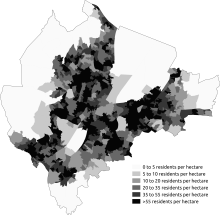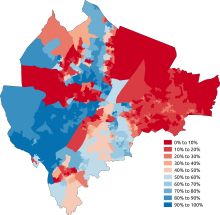Demographics of Belfast
| Demographics of Belfast | |
|---|---|
 Population pyramid of Belfast | |
| Population | 345,418 (2021) |
The city of Belfast is the provincial capital of Northern Ireland. The population of the Belfast Local Government District was 345,418 in 2021. The population within the city limits of Belfast in 2021 was 293,298.[1]
Population[edit]

Population[edit]
| Year | Pop. | ±% p.a. |
|---|---|---|
| 1757 | 8,549 | — |
| 1782 | 13,105 | +1.72% |
| 1791 | 18,320 | +3.79% |
| 1806 | 22,095 | +1.26% |
| 1821 | 37,277 | +3.55% |
| 1831 | 53,287 | +3.64% |
| 1841 | 75,308 | +3.52% |
| 1851 | 97,784 | +2.65% |
| 1861 | 119,393 | +2.02% |
| 1871 | 174,412 | +3.86% |
| 1881 | 208,122 | +1.78% |
| 1891 | 255,950 | +2.09% |
| 1901 | 349,180 | +3.15% |
| 1911 | 386,947 | +1.03% |
| 1926 | 415,151 | +0.47% |
| 1937 | 438,086 | +0.49% |
| 1951 | 443,671 | +0.09% |
| 1961 | 415,856 | −0.65% |
| 1966 | 398,405 | −0.85% |
| 1971 | 362,082 | −1.89% |
| 1981 | 314,270 | −1.41% |
| 1991 | 279,237 | −1.17% |
| 2001 | 277,391 | −0.07% |
| 2006 | 267,374 | −0.73% |
| 2011 | 286,000 | +1.36% |
| 2021 | 293,298 | +0.25% |
| [2][3][4][5][6][7][8] | ||
The total population of Belfast Local Government District was 345,418 in 2021, an increase of 3.5%.[9][1]
Sex[edit]
In 2021, 51% of the population was female while 49% was male.[9]
Age[edit]

The age demographics of Belfast is different to the rest of the constituent country, 18% were aged 0 to 14, 37% aged 15 to 39, 30% aged 40 to 64 and 15% aged 65 and above.[9]
Ethnicity[edit]


Belfast has become in recent decades an ethnically diverse city, although this ethnic diversity is not to the same scale as other cities across the United Kingdom. Previously, the city was exclusively white (categorised as a simplified ethnic group within Northern Ireland) at 98% white in 2001, however by 2021, this had dropped down to 93%.[9]
| Ethnic group | 2001[10] | 2011[11] | 2021[12][13] | |||
|---|---|---|---|---|---|---|
| Number | % | Number | % | Number | % | |
| White: Total | 324,775 | 98.8% | 323,090 | 96.8% | 321,666 | 93.1% |
| White | 324,475 | 98.7% | 322,813 | 96.7% | – | – |
| White: British/Irish/Northern Irish only (national identity) and Christian/no religion/religion not stated (religion) | – | – | – | – | 303,252 | 87.8% |
| White: Other | – | – | – | – | 17,801 | 5.2% |
| White: Irish Traveller/White Gypsy | 300 | 277 | 299 | |||
| White: Roma | – | – | – | – | 314 | |
| Asian or Asian British: Total | 2,181 | 0.6% | 7,208 | 2.2% | 12,908 | 3.7% |
| Asian/Asian British: Indian | 461 | – | 2,330 | 0.7% | 4,361 | 1.3% |
| Asian/Asian British: Pakistani | 187 | – | 258 | – | 492 | |
| Asian/Asian British: Bangladeshi | 68 | – | 210 | – | – | – |
| Asian/Asian British: Chinese | 1,383 | 0.4% | 2,378 | 0.7% | 4,738 | 1.4% |
| Asian/Asian British: Filipino | – | – | – | – | 1,637 | |
| Asian/Asian British: Asian Other | 82 | – | 2,032 | 0.6% | 1,680 | |
| Black or Black British: Total | 320 | – | 1,334 | 0.4% | 4,640 | 1.3% |
| Black or Black British: Caribbean | 67 | – | 95 | – | – | – |
| Black or Black British: African | 168 | – | 1,074 | 0.3% | 4,127 | 1.2% |
| Black or Black British: Other | 85 | – | 165 | – | 513 | |
| Mixed: Total | 837 | – | 1,599 | 0.5% | 4,159 | 1.2% |
| Other: Total | 504 | – | 640 | – | 2,046 | 0.6% |
| Other: Any other ethnic group | – | – | – | – | 1,032 | |
| Other: Arab | – | – | – | – | 1,014 | |
| Ethnic minority: Total | 3,842 | 1.2% | 10,781 | 3.2% | 23,753 | 6.9% |
| Total | 328,617 | 100% | 333,871 | 100% | 345,419 | 100% |
Migration[edit]
Country of birth[edit]
84% of Belfast was born within Northern Ireland, 4% within England, less than 1% for Scotland and Wales, 2% within the Republic of Ireland and 10% from other countries.[9]
Passports held[edit]
43% of Belfast has a UK passport only, 29% has a Republic of Ireland passport only, 6% has both UK and RoI (Republic of Ireland) passports, 8% have other passports and 14% have no passport.[9]

Religion[edit]
Similarly to the trend across all of Northern Ireland, the Protestant population within the city has been in decline, while the non-religious, other religious and Catholic population has risen. In 2021, the proportion of residents who identified as Catholic was 43%, 12% Presbyterian, 8% for the Church of Ireland, 3% Methodist, 6% of Christian religions, 3% other religions and 24% no religion or not stated.[9]
Identity[edit]

In 2021 the largest identity group was 'Irish only' with 35% of the population. After this was; British only 27%, Northern Irish only 17%, British and Northern Irish only 7%, Irish and Northern Irish only 2%, British, Irish and Northern Irish only 2%, British and Irish less than 1% and Other identities with 10%.[9]
References[edit]
- ^ a b "Settlement 2015". NISRA. Retrieved 17 August 2023.
- ^ Wakefield, Edward (1812). An account of Ireland, statistical and political: in two volumes. Vol. 2. London: Longman, Hurst, Rees, Orme and Brown. pp. 693–694. Archived from the original on 31 December 2015. Retrieved 16 October 2015.
- ^ "Census for post 1821 figures". Cso.ie. Archived from the original on 20 September 2010. Retrieved 12 August 2010.
- ^ "Home". Histpop.Org. 2 April 2007. Archived from the original on 7 May 2016. Retrieved 13 November 2010.
- ^ "Northern Ireland Census of Population". Northern Ireland Statistics and Research Agency. Archived from the original on 4 April 2010. Retrieved 12 August 2010.
- ^ Lee, J. J. (1981). "On the accuracy of the Pre-famine Irish censuses". In Goldstrom, J. M.; Clarkson, L. A. (eds.). Irish Population, Economy, and Society: Essays in Honour of the Late K. H. Connell. Oxford, England: Clarendon Press.
- ^ Mokyr, Joel; O Grada, Cormac (November 1984). "New Developments in Irish Population History, 1700–1850". The Economic History Review. 37 (4): 473–488. doi:10.1111/j.1468-0289.1984.tb00344.x. hdl:10197/1406. Archived from the original on 4 December 2012.
- ^ "Belfast City Council. Belfast: A Profile of the City. Demographics". Belfastcity.gov.uk. Archived from the original on 25 September 2010. Retrieved 12 August 2010.
- ^ a b c d e f g h "Belfast Census Data". explore.nisra.gov.uk. Archived from the original on 2022-09-27. Retrieved 2022-09-27.
- ^ "Ethnic Group: KS06 (administrative geographies)". NISRA.
- ^ "2011 Census key statistics tables on ethnicity, identity, language and religion". Northern Ireland Statistics and Research Agency. 2022-08-16. Retrieved 2023-06-25.
- ^ "Racial Equality (The Executive Office)". build.nisra.gov.uk. Retrieved 2023-06-25.
- ^ "Census 2021 main statistics ethnicity tables". Northern Ireland Statistics and Research Agency. 2022-09-07. Retrieved 2022-09-23.
